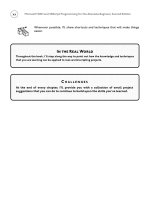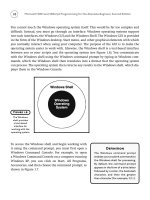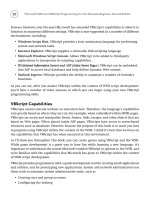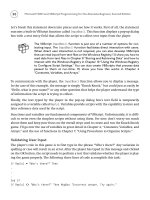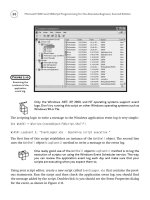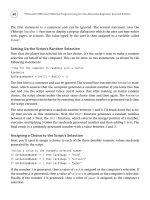Microsoft WSH and VBScript Programming for the Absolute Beginner Part 29 pot
Bạn đang xem bản rút gọn của tài liệu. Xem và tải ngay bản đầy đủ của tài liệu tại đây (101.57 KB, 10 trang )
260
Developing the Logic for the Main Processing Section
The script’s main processing section controls the overall execution of the script. It consists
of 10 function calls and two loops:
SetVariableDefaults()
ProcessScriptIniFile()
CollectPlayerInput()
For intSetCount = 1 to intNoOfPlays
Do Until blnAllNumbersPicked = “True”
GetRandomNumber()
ProcessRandomNumber()
DetermineIfSetIsComplete()
Loop
BuildDisplayString()
ResetVariableDefaults()
Next
DisplayFinalResults()
DisplaySplashScreen()
The first loop is controlled by a For statement that is responsible for making sure that the
script generates the number of sets of lottery numbers specified by the player. The second loop
is controlled by a
Do Until and is responsible for making sure that a full count of numbers is
generated for each set (or play).
Microsoft WSH and VBScript Programming for the Absolute Beginner, Second Edition
Building the SetVariableDefaults() Function
The SetVariableDefaults() function, shown here, is responsible for establishing default val-
ues for a number of variables used by the script. The first two variables are
Boolean and are
used to determine when a full set of lottery numbers has been generated and when the player
has specified a valid number of plays. The second pair of variables is used to store integer
data. The first variable is used to keep track of the number of lottery numbers generated for
each play. The second variable is used to track the number of sets of lottery numbers as the
script is generating them.
Function SetVariableDefaults()
blnAllNumbersPicked = “False”
blnInputValidated = “False”
intNumberCount = 0
intNoOfValidPicks = 0
End Function
Building the ProcessScriptIniFile() Function
The ProcessScriptIniFile() function, shown here, is responsible for reading in script con-
figuration settings from the game’s INI file. Because of the unique task assigned to this func-
tion, I chose to make it completely self contained. Therefore, it begins by defining its own
objects and variables. To make the purpose of each variable clear, I documented each one by
adding comments to the right of each variable when defined as well as to key statements
throughout the function.
Function ProcessScriptIniFile()
Dim FsoObject ‘Sets up a reference to the FileSystemObject
Dim OpenFile ‘Sets up a reference to the script’s INI file
Set FsoObject = WScript.CreateObject(“Scripting.FileSystemObject”)
Dim intEquals ‘Used to parse INI file data
Dim strKeyName ‘Represents a key in the script’s INI file
Dim strSourceFile ‘Specifies the name of the script’s INI file
Dim strInput ‘Represents a line in the script’s INI file
261
Chapter 8 • Storing and Retrieving Data
262
strSourceFile = “LuckyLotteryMachine.ini” ‘Identify script’s INI file
If (FsoObject.FileExists(strSourceFile)) Then ‘Make sure INI file exists
‘Open for reading
Set OpenFile = FsoObject.OpenTextFile(strSourceFile, 1)
Do Until Mid(strInput, 1, 15) = “[GameControls]” ‘Find right section
strInput = OpenFile.ReadLine ‘Read line from the INI file
Loop
‘Read until end of file reached
Do Until OpenFile.AtEndOfStream = “True”
strInput = OpenFile.ReadLine ‘Read a line from the file
If Mid(strInput, 1, 1) = “[“ Then
Exit do ‘If executed, new sections have been found
End If
If Len(strInput) <> 0 Then ‘Executes if a blank line is not found
intEquals = Instr(strInput, “=”) ‘Locate the equals character
strKeyName = Mid(strInput, 1, intEquals - 1) ‘Set key value
Select Case strKeyName ‘Match up key value to script settings
Case “Greeting”
strTitleBarMsg = Mid(strInput, intEquals + 1, Len(strInput))
Case “DisplayFormat”
strDisplayType = Mid(strInput, intEquals + 1, Len(strInput))
Case “NoOfPicks”
intNoOfPicksToSelect = Cint(Mid(strInput, intEquals + 1, _
Len(strInput)))
Case “RangeOfNumbers”
intRangeOfNumbers = Cint(Mid(strInput, intEquals + 1, _
Len(strInput)))
Microsoft WSH and VBScript Programming for the Absolute Beginner, Second Edition
End Select
End If
Loop
OpenFile.Close()’Close the INI file when done reading it
Else
MsgBox “The INI file is missing. Unable to execute.”
WScript.Quit()
End If
End Function
The function begins by instantiating an instance of the FileSystemObject. It then specifies
the location of its INI file. Next, it checks to make sure that the INI file exists and then opens
it. The function then reads the INI file until it finds the
[GameControls] section. Once found,
the function begins reading the rest of the INI file. The function then parses through the
key=value pairs and assigns values to matching script variables using a Select Case statement.
Building the CollectPlayerInput() Function
The CollectPlayerInput() function is responsible for collecting and validating player input.
The overall execution of this function is controlled by the following
Do While loop, which
executes as long as a
Boolean variable named blnInputValidated is not equal to True:
Function CollectPlayerInput()
Do Until blnInputValidated = “True”
intNoOfPlays = InputBox(“How many sets of numbers do “ & _
“you want?”, strTitleBarMsg)
If IsNumeric(intNoOfPlays) <> True Then
MsgBox “Sorry. You must enter a numeric value. Please “ & _
“try again.”, ,strTitleBarMsg
Else
263
Chapter 8 • Storing and Retrieving Data
264
If Len(intNoOfPlays) = 0 Then
MsgBox “Sorry. You must enter a numeric value. Please “ & _
“try again.”, ,strTitleBarMsg
Else
If intNoOfPlays = 0 then
MsgBox “Sorry. Zero is not a valid selection. Please “ & _
“try again.”, ,strTitleBarMsg
Else
blnInputValidated = “True”
End If
End If
End If
Loop
End Function
Three validation tests are performed. The first test uses the VBScript IsNumeric() function to
ensure that the input is numeric. The second test uses the
Len() function to ensure that the
player actually typed in input, as opposed to simply clicking on OK or Cancel. The last valida-
tion test checks to make sure that the player did not enter a value of zero. If the input pro-
vided by the player passes all three of these tests, then a value of
True is assigned to
blnInputValidated and the function finishes executing.
Building the GetRandomNumber() Function
The GetRandomNumber() function, shown here, is responsible for retrieving random numbers
for the script. It begins with the
Randomize statement to ensure that numbers are randomly
generated. Next, a random number is generated. The range from which the number is cre-
ated is dictated by the value assigned to
intRangeOfNumber, which was previously established
by retrieving its value from the script’s INI file.
Function GetRandomNumber()
Randomize
intRandomNo = cInt(FormatNumber(Int((intRangeOfNumbers * Rnd) + 1)))
End Function
Microsoft WSH and VBScript Programming for the Absolute Beginner, Second Edition
Building the ProcessRandomNumber() Function
The ProcessRandomNumber() function, shown here, is responsible for ensuring that the same
lottery number is not picked twice for a given play or set. It accomplishes this by establish-
ing an array named
aintLotteryArray. The array is configured to handle up to 11 entries,
based on the assumption that this is large enough to handle any amount of lottery numbers
a given lottery game might require.
Function ProcessRandomNumber()
Select Case intRandomNo
Case aintLotteryArray(0)
Case aintLotteryArray(1)
Case aintLotteryArray(2)
Case aintLotteryArray(3)
Case aintLotteryArray(4)
Case aintLotteryArray(5)
Case aintLotteryArray(6)
Case aintLotteryArray(7)
Case aintLotteryArray(8)
Case aintLotteryArray(9)
Case aintLotteryArray(10)
Case Else
strLotteryList = strLotteryList & “ “ & intRandomNo & vbTab
intNoOfValidPicks = intNoOfValidPicks + 1
aintLotteryArray(intNumberCount) = intRandomNo
intNumberCount = intNumberCount + 1
End Select
End Function
This function begins by comparing the value of the last lottery number that was generated to
the numbers stored in the array. The first time through, there won’t be any lottery numbers
stored in the array yet. As a result, the lottery number is stored as the first entry in the array.
Also, the lottery number is added to a string that is stored in a variable named
strLotteryList,
which is used elsewhere in the script. Finally, the total number of valid lottery numbers is
tracked by adding
1 to intNoOfValidPicks each time a unique lottery number is generated.
265
Chapter 8 • Storing and Retrieving Data
266
Each time this function is called, it checks to see whether the most recently generated random
number matches any of the numbers already stored in the array. If it does, nothing happens;
otherwise, that number is added to the array.
Building the DetermineIfSetIsComplete() Function
The DetermineIfSetIsComplete() function, shown here, compares the value stored in
intNoOfValidPicks to the value stored in intNoOfPicksToSelect to determine whether a com-
plete set of lottery numbers has been generated. If a complete set has been generated, then
DetermineIfSetIsComplete() sets the value assigned to blnAllNumbersPicked equal to True.
Otherwise, the value assigned to this variable remains set equal to
False.
Function DetermineIfSetIsComplete
If intNoOfValidPicks = intNoOfPicksToSelect Then
blnAllNumbersPicked = “True”
End If
End Function
Building the BuildDisplayString() Function
The BuildDisplayString() function, shown here, takes the string stored in the strLotteryList
variable (which is created by the ProcessRandomNumber() function) and uses it to build a larger
string made up of all the sets of lottery numbers generated by the game. This string is later
used to display the game’s result to the player. To make the displayed output more attractive,
this function uses the
vbTab constant to organize output into a multi-column format.
Function BuildDisplayString()
strLotteryList = intSetCount & “)” & vbTab & strLotteryList
strDisplayString = strDisplayString & strLotteryList & _
vbCrLf & vbCrLf & vbCrLf
End Function
Building the ResetVariableDefaults() Function
The ResetVariableDefaults() function, shown here, is used to reset variable values back to
their initial default settings after a full set of lottery numbers has been generated. This readies
the script to begin generating additional sets of numbers.
Microsoft WSH and VBScript Programming for the Absolute Beginner, Second Edition
Function ResetVariableDefaults()
blnAllNumbersPicked = “False”
intNoOfValidPicks = 0
intNumberCount = 0
strLotteryList = “”
End Function
Building the DisplayFinalResults() Function
The DisplayFinalResults() function, shown here, is responsible for displaying all the sets of
lottery numbers that are generated. It displays this information in one of two formats based
on the value assigned to
strDisplayType, which is a variable whose value was set earlier in
the script by retrieving its value from the script’s INI file. If
strDisplayType is equal to Full,
then the function displays information regarding the number of lottery numbers that was
generated per set as well as the total number of sets that were created, followed by the num-
bers that made up each set. However, if the value assigned to
strDisplayType is equal to any-
thing other than
Full, then only the sets of lottery numbers are displayed.
Function DisplayFinalResults()
If strDisplayType = “Full” Then
MsgBox vbCrLf & _
“L U C K Y L O T T E R Y N U M B E R P I C K E R” & _
vbCrLf & vbCrLf & _
“——————————————————————————-” & _
“——————————————-” & vbCrLf & vbCrLf & _
“Number of plays: “ & intNoOfPlays & vbCrLf &vbCrLf & _
“Number of picks per play: “ & intNoOfPicksToSelect & _
vbCrLf & vbCrLf & _
“——————————————————————————-” & _
“——————————————-” & vbCrLf & vbCrLf & vbCrLf & _
“Your lottery numbers are: “ & vbCrLf & vbCrLf & vbCrLf & _
strDisplayString, , strTitleBarMsg
Else
267
Chapter 8 • Storing and Retrieving Data
268
MsgBox vbCrLf & _
“L U C K Y L O T T E R Y N U M B E R P I C K E R” & _
vbCrLf & vbCrLf & _
“——————————————————————————-” & _
“——————————————-” & vbCrLf & vbCrLf & _
“Your lottery numbers are: “ & vbCrLf & vbCrLf & vbCrLf & _
strDisplayString, , strTitleBarMsg
End If
End Function
Building the DisplaySplashScreen() Function
This last function in the script displays the game’s splash screen, providing information
about the game and its creator as well as an invitation for the player to return and play
again another time.
Function DisplaySplashScreen()
MsgBox “Thank you for using the Lucky Lottery Number Picker “ & _
“© Jerry Ford 2004.” & vbCrLf & vbCrLf & “Please play again “ & _
“soon!”, 4144, strTitleBarMsg
WScript.Quit()
End Function
The last statement in the function terminates the script’s execution using the WScript
Quit()
method.
The Final Result
That’s it. You’re all done. Your fully assembled script should look like this:
‘*************************************************************************
‘Script Name: LuckyLotteryNumberPicker.vbs
‘Author: Jerry Ford
‘Created: 11/08/04
‘Description: This script randomly picks lottery numbers.
‘*************************************************************************
Microsoft WSH and VBScript Programming for the Absolute Beginner, Second Edition
‘Initialization Section
Option Explicit
Dim aintLotteryArray(10) ‘Stores randomly generated lottery numbers
Dim blnAllNumbersPicked ‘Determines when a set of #s has been created
Dim blnInputValidated ‘Set to True when the player enters a valid number
Dim intNumberCount ‘Tracks the number of picks for a given play
Dim intNoOfValidPicks ‘Tracks the # of valid selections for a given set
Dim intNoOfPlays ‘Determines the # of sets of lottery #s to create
Dim intSetCount ‘Used to track how many sets have been generated
Dim intRandomNo ‘Used to store randomly generated lottery #s
Dim intNoOfPicksToSelect ‘Specifies how many #s to generate for each set
Dim intRangeOfNumbers ‘Specifies range to use when generating random #s
Dim strLotteryList ‘Displays a string showing 1 set of lottery #s
Dim strDisplayString ‘Used to display the list of selected lottery #s
Dim strDisplayType ‘Specifies whether to show full or summary data
Dim strTitleBarMsg ‘Specifies title bar message in pop-up dialogs
‘Main Processing Section ————————————————————————-
SetVariableDefaults()
ProcessScriptIniFile()
CollectPlayerInput()
For intSetCount = 1 to intNoOfPlays
Do Until blnAllNumbersPicked = “True”
GetRandomNumber()
269
Chapter 8 • Storing and Retrieving Data



